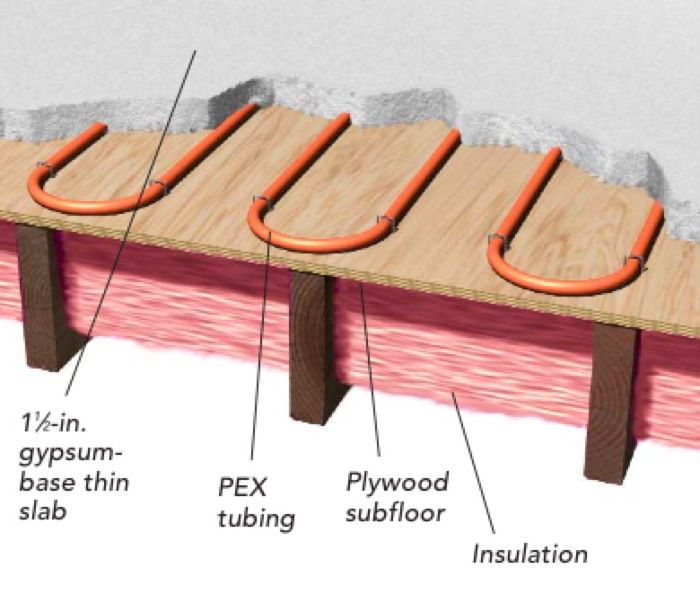
What’s the best way to install radiant floor heating?
Lukas Smith is planning a radiant-floor heating system for his fairly large but well insulated house in southern Ontario. He wonders whether the hot water can be supplied by a water heater rather than a boiler, and how to provide air conditioning.
Lukas’s post in the Q&A forum at GreenBuildingAdvisor is an effort to settle the fine points of the design, and the subject of this week’s Q&A Spotlight.
Is radiant heat right for this home?
Some of the answers may have surprised him. While some responses steered Smith toward non-boiler options for heating water for the radiant-floor tubing, other posters suggested there might be more economical ways of heating the house altogether. Chief among them is the ductless mini-split, a type of air-to-air heat pump.
Conventional air source heat pumps lose efficiency rapidly as temperatures fall, but newer designs such as a Mitsubishi Electric model perform much better in very low temperatures. One Connecticut homeowner reports that heat so far this year has cost hiim a paltry $170.
Even better, heat pumps provide air conditioning as well as heat, something that radiant-floor heating systems can’t do.
Read the whole article at Green Building Advisor.
Further Resources
Improvised Radiant Heat in A Bathroom Floor
Energy Efficient From the Ground Up
Fine Homebuilding Recommended Products
Fine Homebuilding receives a commission for items purchased through links on this site, including Amazon Associates and other affiliate advertising programs.

8067 All-Weather Flashing Tape

Handy Heat Gun

Affordable IR Camera

One builder is getting mixed messages about the benefits of burying radiant-heat tubing in a lightweight slab.



























View Comments
Yes its petty,
Is your comment based on $$? "heat pumps provide air conditioning as well as heat, something that radiant-floor heating systems can't do"
Radiant-floor can do it, if you have a air to air, or ground source heat pumps!
The caviet is, unless your promoting ductless, they cost more!
All else constant, I say radiant is best; As far as comfort goes. Another reason I really like it is for environmental quality. Having forced air blowing around can create a poor living environment if the system is not extremely well filtered.
when all is is not constant-
But infloor hydronics is not always an option and there are many many options which all are site/situation specific.
How does running domestic water through a hydronic system effect the components? erosion etc?
the mini-split sounds like a great option.
lots to think about here
We have just done a four unit townhouse with 'pex' stapled to the underside of the plywood sub-floor. The heat is supplied from a water to water heat-exchanger that is heated by a high efficient instant natural gas hot water heater. The w-w heat exchanger provides the separation that keeps domestic water from the heating loops. Thermostats and control valves allow zoning. These systems are working very well, they give a warm floor do not take up floor or wall space, and are performing very well in a 11,500 DD climate where the temperature went to -40 degrees this winter. Another advantage is the total furnace (boiler)and hot water heater use a space on the exterior wall 12" x 48" that can be enclosed in a built in cupboard.
I actually didn't know that radiant underfloor heating systems were done using water until I started doing some research (and ended up here). I did some work with a company called CBS Radiant Heating in Australia and they were using low voltage ultra thin cabling under the floor boards / carpet (whatever covering). *Apparently* it's more efficient but looking at the comments here maybe less well known / less used?
Many of our customers pick comfort as the #1 reason they want radiant heat. I don't think there's any dispute that floor heating is the most comfortable way to heat a space. Although, here in VT, many love the comfort of their warm wood stoves!
Radiant heat does have the black-eye of being very expensive to install but it doesn't have to be that way. Much of the cost associated with it is labor and if you're a savvy do-it-yourselfer then you can do much of the labor intensive part which is installing the tubing.
So in the end it comes down to the fact that if you don't have to pay too much for the radiant system, it can be a great choice in a well insulated home. Just be sure to use floor controls instead of ambient air t-stats.
As for cooling, many of our customers will opt for a ductless mini-split in areas or go with spot ac units for those ares they want to keep cool. If you have any questions, you can reach me at http://www.radiantec.com